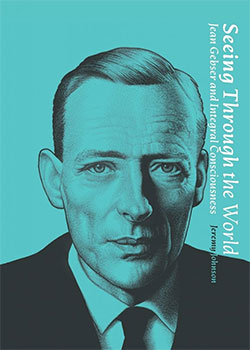Cynthia Bourgeault continues her series of reflections upon Integral structures of consciousness and ideas brought forth in Jean Gebser’s book, Ever Present Origin (EPO). See below for related resources and links to prior posts.
*****
After a long hiatus, I am finally back on my task of exploring the surprisingly fruitful interconnections between the work of Jean Gebser and G.I. Gurdjieff. While neither man officially acknowledged the other’s teaching (nor in the case of Gurdjieff, had likely even heard of it!), their respective takes on the conscious evolution of humanity are more in sync than you might initially suspect, and the rich Gurdjieffian repertory of consciousness-transforming practices offers itself as a powerful and by-and-large overlooked resource for “putting legs” on Gebser’s intuitively brilliant but highly cerebralized vision of evolutionary emergence.
Today’s topic, three-centered awareness, is a good starting point.
According to Gebser, one of the chief hallmarks of the rising Integral structure of consciousness is that it will feature a whole new method of verition, as he calls it—i.e., of verifying to ourselves what we know. This system will be totally unlike the weary dialectics of the mental structure of consciousness and will feature not only a new depth of consciousness (Gebser calls it a “fourth dimension”), but also a more energized and in fact transmissory presence. It will reveal itself, as Gebser repeatedly emphasizes, as “not an expansion but an intensification of consciousness.”
But alas, trying to describe a fourth dimension to those as yet accustomed to thinking only in three is roughly the same impasse (but one dimension down) so brilliantly exposed by Edwin Abbot in his classic sci-fi allegory Flatland, where a pilgrim returning from the world of solid geometry tries in vain to explain this new “third” dimension to his fellow plane-dwellers. You simply can’t visualize a dimension that has not yet been activated in you. And so it is predictably at this point that Gebser becomes his most frustratingly cerebral, flooding us in a downpour of neologisms (like “awaring,” “systasis,” “synaresis,” “aperspectival,” “the achronon”) which may bedazzle us with intellectual catnip, but in the end seem to land somewhere in the ballpark of “sounding gongs or clashing cymbals.” As the poet e.e. cummings once poignantly put it: “great words, writhing overmuch, stand[ing] helplessly before the spirit at bay.”
This is exactly where Gurdjieff’s foundational teaching of three-centered awareness can come to our assistance. Gurdieff’s own take on the mechanics of conscious perception offers a concrete, and I believe remarkably serviceable, starting point for beginning to picture this new dimension of consciousness. But even more importantly, for beginning to work with it.
According to Gurdjieff, human consciousness is uniquely distinguished by its “three centered awareness.” By this he means that consciousness does not reside merely in the mental faculty alone (a misassumption made by nearly all phenomenologists, Gebser included), but rests on a tripod of three distinct systems of perception which he calls “intellectual center,” “moving center,” and “emotional center.” The intellectual center is headquartered in the brain and is concerned mainly with the weighing, comparing, and strategic application of cognitive data. The moving center, dispersed throughout the body but centralized in the spine, is about “intelligence in motion”—i.e., perceiving the world through sensation, gesture, rhythm, and movement. The emotional center (not to be confused with “feeling,” which is of a different quality altogether) is carried primarily in the nervous system but is concentrated in the region of the solar plexus. It perceives the world through empathetic resonance and/or emotional polarity.
In Gurdjieff’s take, in order to fully qualify as a “conscious human being” all three centers must be online and in communication with one another. Otherwise, one is technically asleep, no matter how passionately or eruditely any single center may be holding forth at any given moment.
According to this delusion-busting analysis, most of the great intellectual work of Western civilization has been carried out in sleep—and continues to be carried out in sleep.
Short, quantitative, and brutal. No more batting around terminology (as if the naming of something established claim to its possession.) No more speculating and emoting about whether I am one of the rising Integral elite. Instead, simply, Where are my feet? If I can’t answer—if I can’t in this moment sense my direct connection to my position in time and space—I can pretty much conclude that my vaunted Integral emergence is still a dream playing in my mind.
When the experience of working from a balanced awareness is touched, however —even fleetingly—something miraculous happens. The entire body is filled with a vital and harmonizing energy (“integral,” if you want to call it that.) And at the same time, a connection opens up to the two higher centers—higher emotional and higher intellectual—from which objective knowing and authentic feeling indeed pour forth. Once the three lower centers are trained and stable enough not to buckle in the face of this far more intense conscious infusion, you are at last (for the most part) a reliably “conscious human being” and are ready to take up your post in the cosmic dance of giving-and-receiving with authentic clarity and agency. You are no longer simply a consumer but a transformer of life force.
Gurdjieff’s straightforward schematic also yields a veritable treasure trove of daily exercises, movements, and teachings geared toward supporting this “waking up” process and the stabilization three-centered awareness. As such, the Gurdjieff Work offers itself as a powerful gateway and user’s guide to the midwifing of the emergent Integral structure of consciousness on both an individual and collective basis. Just how powerful a small group of my Wisdom students were amazed to discover when the pandemic accidentally threw us into the forced company of Gebser’s Ever Present Origin and Joseph Azize’s new collection of the Gurdjieff Exercises. Strange bedfellows indeed, it first appeared. But as we worked diligently with these resources for more than a year (and the work still continues), it was extraordinary to discover how deeply these teachings unlocked and energized each other, and how unexpectedly they bestowed on us a whole new set of inner resources for coping with the mounting anxiety and fragmentation of our outer world.
Of course, the delineation between “knowledge” and “being” is by no means original with Gurdjieff. As the Quaker mystic Isaac Pennington famously commented back in the 17th century: “There is a great difference between comprehending the knowledge of things and tasting the hidden life of them.” This full tasting is what Gurdjieff’s “being-consciousness” is all about, and I believe it also fundamentally what Gebser’s “verition” is all about. It also just may be what St Paul is touching on when he concludes his profound teaching on Love in 1 Corinthians 13 with the mysterious affirmation: “For now I see through a glass darkly, but later face to face; now I know in part, but later will I know even as also I am known.”
This dynamic, creative interplay between knowing and being-known, between seeing and being-seen-through, is, I believe, none other than the radiance of Gebser’s Originary Presence shining through our fragile human form. Like a beacon, finitude both manifests and transmits light; it “magnifies the lord.” We can become those light-stations as we are increasingly able to do the work. And willing to pay the cost.
If you’re new to Gebser’s revelatory ideas, Cynthia recommends starting with Seeing Through the World: Jean Gebster and Integral Consciousness, by Jeremy Johnson, available at Amazon.com or Revelore Press.
You can find helpful commentary and instruction on some of the Gurdjieff practices in Cynthia’s MYSTICAL COURAGE: Commentaries on Selected Contemplative Exercises by G.I. Gurdjieff, as Compiled by Joseph Azize. Learn more here.



